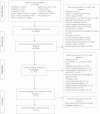Effects of exercise on BMI z-score in overweight and obese children and adolescents: a systematic review with meta-analysis
- PMID: 25204857
- PMCID: PMC4180550
- DOI: 10.1186/1471-2431-14-225
Effects of exercise on BMI z-score in overweight and obese children and adolescents: a systematic review with meta-analysis
Abstract
Background: Overweight and obesity are major public health problems in children and adolescents. The purpose of this study was to conduct a systematic review with meta-analysis to determine the effects of exercise (aerobic, strength or both) on body mass index (BMI) z-score in overweight and obese children and adolescents.
Methods: Studies were included if they were randomized controlled exercise intervention trials ≥ 4 weeks in overweight and obese children and adolescents 2 to 18 years of age, published in any language between 1990-2012 and in which data were available for BMI z-score. Studies were retrieved by searching eleven electronic databases, cross-referencing and expert review. Two authors (GAK, KSK) selected and abstracted data. Bias was assessed using the Cochrane Risk of Bias Assessment Instrument. Exercise minus control group changes were calculated from each study and weighted by the inverse of the variance. All results were pooled using a random-effects model with non-overlapping 95% confidence intervals (CI) considered statistically significant. Heterogeneity was assessed using Q and I2 while funnel plots and Egger's regression test were used to assess for small-study effects. Influence and cumulative meta-analysis were performed as well as moderator and meta-regression analyses.
Results: Of the 4,999 citations reviewed, 835 children and adolescents (456 exercise, 379 control) from 10 studies representing 21 groups (11 exercise, 10 control) were included. On average, exercise took place 4 x week for 43 minutes per session over 16 weeks. Overall, a statistically significant reduction equivalent to 3% was found for BMI z-score (Χ¯, -0.06, 95% CI, -0.09 to -0.03; Q = 24.9, p = 0.01; I(2)=59.8%). No small-study effects were observed and results remained statistically significant when each study was deleted from the model once. Based on cumulative meta-analysis, results have been statistically significant since 2009. None of the moderator or meta-regression analyses were statistically significant. The number-needed-to treat was 107 with an estimated 116,822 million obese US children and adolescents and approximately 1 million overweight and obese children and adolescents worldwide potentially improving their BMI z-score by participating in exercise.
Conclusions: Exercise improves BMI z-score in overweight and obese children and adolescents and should be recommended in this population group. However, a need exists for additional studies on this topic.
Figures






Similar articles
-
Diet, physical activity and behavioural interventions for the treatment of overweight or obese children from the age of 6 to 11 years.Cochrane Database Syst Rev. 2017 Jun 22;6(6):CD012651. doi: 10.1002/14651858.CD012651. Cochrane Database Syst Rev. 2017. PMID: 28639319 Free PMC article.
-
Diet, physical activity and behavioural interventions for the treatment of overweight or obese adolescents aged 12 to 17 years.Cochrane Database Syst Rev. 2017 Jun 22;6(6):CD012691. doi: 10.1002/14651858.CD012691. Cochrane Database Syst Rev. 2017. PMID: 28639320 Free PMC article.
-
Gut microbiome-based interventions for the management of obesity in children and adolescents aged up to 19 years.Cochrane Database Syst Rev. 2025 Jul 10;7(7):CD015875. doi: 10.1002/14651858.CD015875. Cochrane Database Syst Rev. 2025. PMID: 40637175 Review.
-
Lifestyle intervention for improving school achievement in overweight or obese children and adolescents.Cochrane Database Syst Rev. 2014 Mar 14;(3):CD009728. doi: 10.1002/14651858.CD009728.pub2. Cochrane Database Syst Rev. 2014. Update in: Cochrane Database Syst Rev. 2018 Jan 29;1:CD009728. doi: 10.1002/14651858.CD009728.pub3. PMID: 24627300 Updated.
-
Physical exercise training interventions for children and young adults during and after treatment for childhood cancer.Cochrane Database Syst Rev. 2016 Mar 31;3(3):CD008796. doi: 10.1002/14651858.CD008796.pub3. Cochrane Database Syst Rev. 2016. PMID: 27030386 Free PMC article.
Cited by
-
Body mass index and associated factors among refugees living in North Rhine-Westphalia, Germany: a cross-sectional study.BMC Nutr. 2021 Aug 26;7(1):54. doi: 10.1186/s40795-021-00453-z. BMC Nutr. 2021. PMID: 34433497 Free PMC article.
-
The effect of exercise training videos on self-esteem of 7-10-year-old obese girls: A randomized controlled trial.BMC Public Health. 2025 May 7;25(1):1684. doi: 10.1186/s12889-025-22832-y. BMC Public Health. 2025. PMID: 40336009 Free PMC article. Clinical Trial.
-
Exercise and BMI z-score in overweight and obese children and adolescents: protocol for a systematic review and network meta-analysis of randomised trials.BMJ Open. 2016 Apr 15;6(4):e011258. doi: 10.1136/bmjopen-2016-011258. BMJ Open. 2016. PMID: 27084289 Free PMC article.
-
Executive Summary of the 2018 Joint Consensus Document on Cardiovascular Disease Prevention in Italy.High Blood Press Cardiovasc Prev. 2018 Sep;25(3):327-341. doi: 10.1007/s40292-018-0278-8. Epub 2018 Sep 20. High Blood Press Cardiovasc Prev. 2018. PMID: 30232768 Review.
-
BMI z-Scores are a poor indicator of adiposity among 2- to 19-year-olds with very high BMIs, NHANES 1999-2000 to 2013-2014.Obesity (Silver Spring). 2017 Apr;25(4):739-746. doi: 10.1002/oby.21782. Epub 2017 Feb 28. Obesity (Silver Spring). 2017. PMID: 28245098 Free PMC article.
References
-
- August GP, Caprio S, Fennoy I, Freemark M, Kaufman FR, Lustig RH, Silverstein JH, Speiser PW, Styne DM, Montori VM. Prevention and treatment of pediatric obesity: an endocrine society clinical practice guideline based on expert opinion. J Clin Endocrinol Metab. 2008;93:4576–4599. doi: 10.1210/jc.2007-2458. - DOI - PMC - PubMed
Pre-publication history
-
- The pre-publication history for this paper can be accessed here: http://www.biomedcentral.com/1471-2431/14/225/prepub
Publication types
MeSH terms
Substances
LinkOut - more resources
Full Text Sources
Other Literature Sources
Medical

